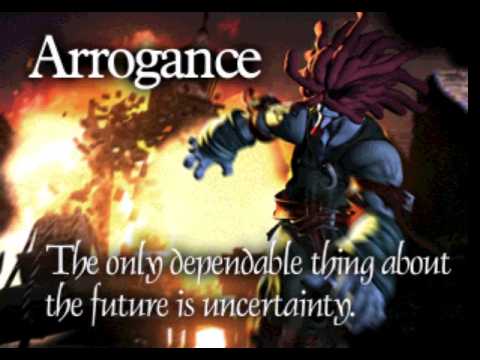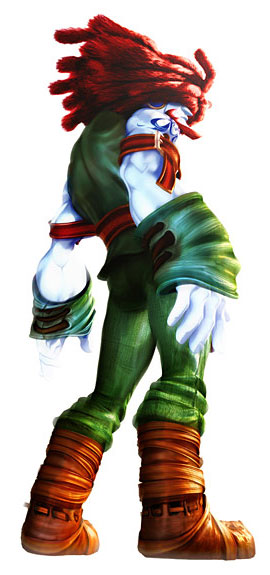The Construction of a Rogue with a Heart in Final Fantasy IX
By thatpinguino 10 Comments
My favorite game when I was growing up was Final Fantasy IX. I loved every character in that game, especially the more “colorful” characters like Freya the rat-woman dragoon and Quina gender-ambiguous, blue-mage chef. My favorite of all of them was Amarant, the rogue with a heart. He is the classic, archetypal, "he is your enemy at first but then joins you because he really is a good guy deep down inside," rogue. I always loved his silly red dreadlocks and his lone wolf dialog, but during my first few playthroughs I couldn’t find a way to actually use him in my party. You see, he really is one of the only characters in Final Fantasy IX that does not seem to have a clear place in combat. He doesn’t deal a ton of damage, he does not heal particularly well, and his most damaging attacks throw money or weapons at the enemy. Furthermore, all of Amarant’s abilities only target single characters; this made it difficult to count on him to be a healer or a damage dealer. He was a little bit of everything and completely incomprehensible to a young me.

When I went back to the game some years later I took it upon myself to finish the game using Amarant in my party. As I forced myself to use this awkward character some of his abilities really did not make sense to me. Throughout the story he acts like a loner and a cut-throat: someone who, until he joins the party halfway through the game, is supposed to be completely self-sufficient. This image fell in line with some of his skills. For example, his chakra ability healed one character’s hp and mp by a small amount. This ability made perfect sense for a loner; he could heal himself and keep his mp high so he would not need items or rest to recover. Even his throw abilities made sense as money and possessions seemed of little value to him. Yet, abilities like revive, curse, and cover made no sense for a self-sufficient loner to have. Curse was an ability that inflicted a random elemental weakness on an enemy. Revive, well , revived one ally. Cover allowed Amarant to take damage in place of one of his allies when they were attacked. It was odd that Amarant could create elemental weaknesses as he has no elemental attacks; he could not exploit the weaknesses he created. Revive made little sense because he could not heal himself if he was already knocked out. Also, cover made little sense because a loner would not have an ally to cover.

These abilities did not fit the lone warrior persona that Amarant had shown through much of the game; however, they did make a lot of sense when Amarant became a willing party member and opened up a little. Towards the end of the game Amarant learns the value of teamwork after an encounter in Ipsen’s Castle, during which he elects to go solo into one of the most dangerous dungeons in the game. He expectedly gets beaten to a pulp before being saved by Zidane. From this moment on Amarant became a full member of the party: no more espousing the virtues of solitude and no more complaining about the other party members holding him back. It is at this point that I realized Amarant’s role in combat and in the game.
He was the ultimate “glue guy.” Amarant’s role was to do the dirty work and the support stuff that other characters cannot. He could heal other character’s mp; he could revive allies; he could cast auto-life and regen; he could deal good damage; he could create weaknesses for others to exploit. When he tranced (FFIX’s version of a limit break) he became an even better role-player as all of his abilities changed from target-one to target-all. He was the most versatile and unique support character in my party and the little touches to his abilities, as well as some story turns, made me see it. Using him in this capacity I was able to cruise through the game, until the final boss. My whole party was mauled by the final boss’s high damage attacks and my healers were berserk, yet Amarant’s healing abilities kept everyone alive. His high damage throw ability added a much needed punch to my attack. Once he reached trance I was able to make my party near-invincible, thanks to his aura ability which cast auto-life and regen on the whole team. At one point he was the last man standing and, thanks to trance, he was able to cast revive on everyone, thus saving the team. The former loner became my team MVP.
What makes this character so interesting for me now is the subtle design decisions that made him more than a sum of his parts. Amarant was not the simple mix of Final Fantasy character classes that he seemed to be at first: ninja, samurai, and monk. In a game where many characters simply were their archetypes in both story and gameplay, Amarant was a character who created a new archetype. The rogue with a heart may not be a new character type, but the way his abilities complemented his characterization was new, at least for me. It is one thing to talk about his heart in cut-scenes, but it is quite another to allow me to discover it in a heated boss battle when he is the only thing keeping my party alive. Amarant’s character development was not merely aesthetic, but it was taken into account in his abilities.

10 Comments